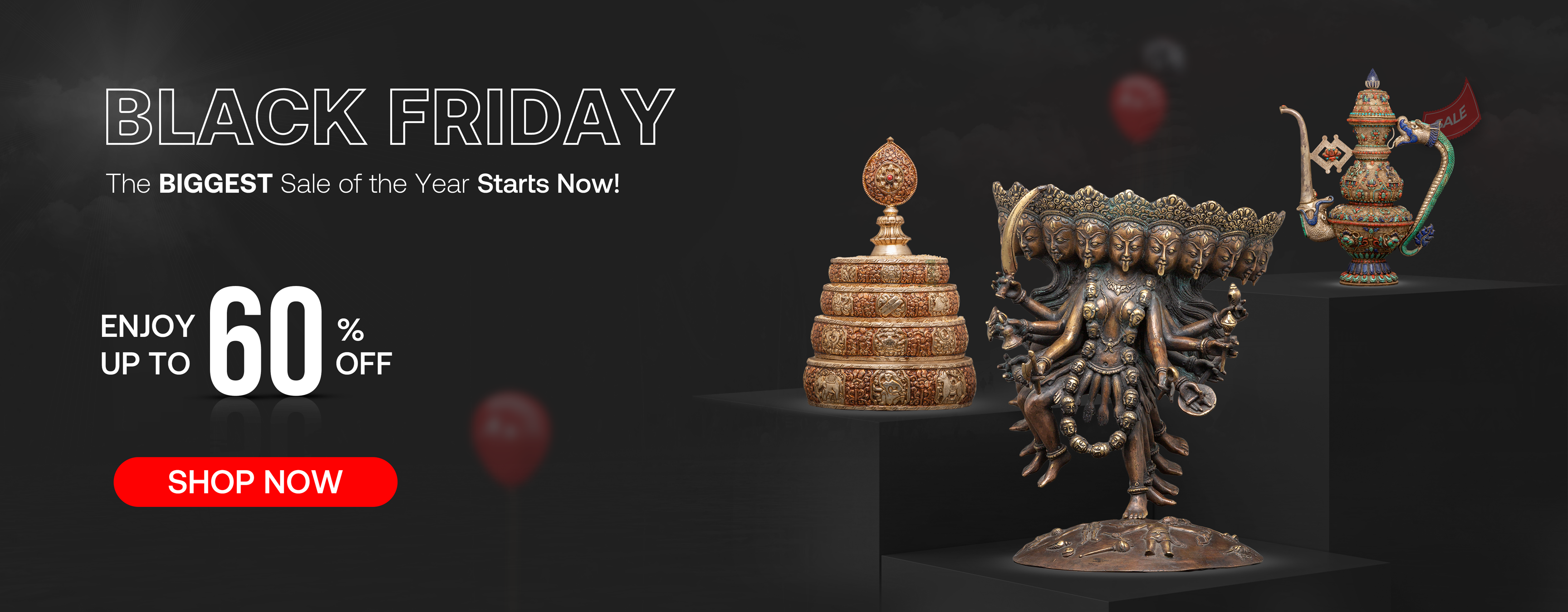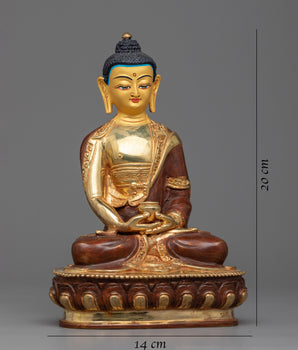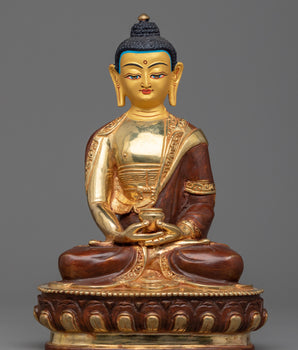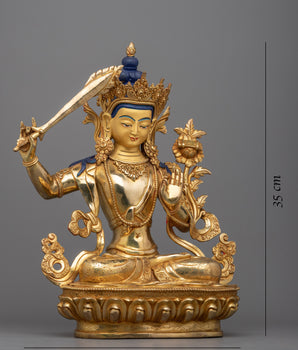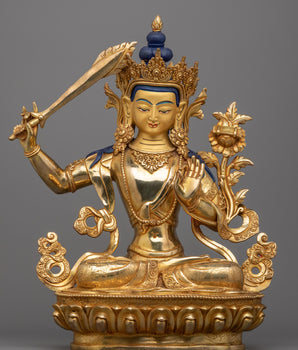A Unique Sacred Feminine Collection for Art Collectors
In Tibetan and Himalayan Buddhist art, Thangka painting is a revered tradition that acts as a visual text that leads practitioners on their spiritual paths. Buddhas, bodhisattvas, guardian deities, and cosmic mandalas are all depicted in these elaborate scroll paintings, which serve as meditation aids and philosophical teaching aids. Devoted to upholding this age-old custom, Evamratna stands out for its exquisite and effective representations of female deities, a significant aspect of Buddhism. Viewers are given a deep spiritual experience by these paintings, which encourage reflection on the feminine facets of enlightenment and the transformational potential of the sacred feminine in everyday life.
The Divine Feminine in Thangka

In Buddhism, the female deities are viewed as representatives of great spiritual teachings, not only as pictures of beauty. They represent kindness, wise decision-making, changes, and defense. Each deity in her collection has a set of unique symbols and traits.
1. Green Tara
The main figure, Green Tara, is respected for her wisdom and compassion among Tara's many manifestations. She is frequently sought after to eliminate obstacles, calm our anxieties, and protect us from any situation that worries us. Green Tara, who represents enlightenment, is accompanied by twenty-one emanations, emphasizing her concern for other individuals. The twenty-one Taras protect people from all threats, calamities, and anxieties while providing them with firm guidance through every obstacle they might come across.
Iconography of Green Tara
- Green Body: Indicates alive compassion that carries healing power and revitalizes the energy in life.
- Seated Position: Tara is shown in a position where her body is still, except for her leg, which is fairly extended as if preparing to move.
- Right Hand: It was adopted in the shape of a varada mudra, which means to give and care, and it was offered to everyone around it.
- Left Hand: Holds a lotus (utpala) and forms the abhaya mudra, which means protection and fearlessness.
- Lotus Throne & Moon Disc: Her position on a lotus and moon symbolizes her enlightenment, gentleness, and purity.
The cycle of Tara’s 21 forms
Twenty-one separate figures of individual Green Tara are shown around the main Green Tara, each with its own set of symbols, attributes, and color. They demonstrate a range of enlightened functions, from peace, healing, and calm, to intensity, anger, and protection.
Some of the Noble forms include:
|
Tara Form |
Color |
Attributes and Role |
|
Red Tara |
Red |
Attraction of positive energies, empowerment, and influence |
|
White Tara |
White |
Longevity, nurturing compassion, and healing energy |
|
Black Tara |
Black |
Fierce protection, elimination of curses, and shielding from harm |
|
Yellow Tara |
Yellow |
Prosperity, wealth, and expansion of abundance |
|
Blue Tara |
Blue |
Removal of obstacles, calming forces, and pacification |
2. Vajrayogini

Click Here to View Our Vajrayogini
In Vajrayana Buddhism, Vajrayogini is a supreme female deity, respected for embodying the greatest wisdom and the powerful qualities of an enlightened woman. Vajrayogini helps those who follow her with special practices that lead to inner awakening. She is called upon to help serious meditators overcome their egos, clingings, and illusions, so that they can be free. She is also known as the principal female deity of Tantra.
Iconography of Vajrayogini
Red Body: Indicates having a passionate mind and a powerful sense of transformation.
Posture: Dancing position, representing the active power of transforming and being set free.
Right Hand: Usually holds a curved knife (kartika), which helps to remove delusion and attachment to one’s.
Left hand: Holds a skull cup(kapala), representing the change of everyday worldly problems into wisdom.
Crown of Skulls: This symbol shows the crossing of life and death to overcome ego.
Third Eye: Helps her understand all aspects and situations from her forehead.
The Circle of Dakinis
Dakinis are wise women who show different aspects of being enlightened. They appear to guide us, care for us, and offer us wisdom and inspiration in spiritual matters. In the tantric tradition, they are regarded as living beings who aid spiritual growth.
Some of the Noble forms include:
|
Dakini Forms |
Color |
Attributes |
|
Vajravarahi |
Red |
Powerful wisdom, overcoming negative energy, and eradicating ignorance |
|
Simkamukha |
Blue |
A protector with a lion’s head, who removes difficulties and negative influences |
|
Kurukulla |
Red |
leads to charm, attracting good causes, power, and encouragement |
|
Troma Nagmo |
Black |
A frightening figure who cuts away ego and guides someone right to emptiness |
|
Yeshe Tsogyal |
White |
Consort of Padmasambhava, who guides others with her pure wisdom and feminine power |
|
Machig Labdron |
White |
A founder of Chöd who taught against the ego and being attached to the self |
|
Manadarava |
Light Red |
These Bhadra Issues features Guru Rinpoche’s enlightened consort, who is known for living long and attaining realization. |
3. Machig Labdron

Machig Labdron introduced the Chöd practice in the 11th century; it focuses on reducing the influence of the ego through spiritual practices. She established a Buddhist circle in Tibet that would be carried to India and provide individuals with ways to accept that all things are impermanent and without distinction.
Iconography of Machig Labdron
- White Body: Symbolizes being pure and clear in mind, as well as the strength of being a woman.
- Position: The motif of dancing is meant to reflect liberation from selfishness and separation.
- Right Hand: Holds a damaru (hand drum), illustrating the clear teaching that eliminates ignorant ideas and serves us clarity.
- Left Hand: Holding vajra (thunderbolt) , which expresses emptiness and the insightful wisdom of Prajnaparamita, is considered the Mother of all Buddhas.
- A skull and ornaments: The skull cup is typically adorned with bone pieces to symbolize the Buddhist ideas of change and overcoming death.
The Lineage Holders and Deities
Machig Labdron’s students and learned beings continue to promote and guide the teachings of Chöd. The style of the composition, which looks like a sprouting tree, reflects the background story that guides yoga.
Upper Section:
The Buddha Shakyamuni was the one who first shared the teachings of the faith.
Prajnaparamita is called the Mother of all Buddhas because she represents perfect wisdom.
Guru Padmasambhava played a vital role in the development of Tibetan Vajrayana.
Middle and Lower Centers:
The Indian Mahasiddhas, such as the teacher and consort Dampa Sangye of Machig.
Tibetan men and women yogis who held to and practiced Chöd.
Bhairava reminds us of suffering and Ganesha of happiness, to tell us what yoga can do.
Dharmapalas and protective spirits are there to guard the teaching from becoming mixed.
A chain of teachers has helped carry the realization forward until now.
5. Prajaparamita

The “Perfection of Wisdom” in Mahayana Buddhism symbolizes absolute wisdom. She also became the spiritual mother of all Buddhas and stands for the full understanding of emptiness, which is the ultimate nature of every phenomenon. A personified form of insight that appears beyond conceptual thought, Prajnaparamita is a sacred text tradition.
Iconography of Prajnaparamita
White body: Represents purity, brightness, and luminous clarity.
Posture: Symbolizes enlightenment and steadiness in meditation by the sitting position.
Left hand: Holds the Lotus signifying inner training and ultimate wisdom.
Right hand: The varada mudra, which bestows blessings and supreme insight
Crown of Five Buddhas: represents mastery of the five wisdoms.
Expression: The calmness of the mind resting in emptiness is reflected
Embodiment of Prajnaparamita
The Five Paramitas, or Perfections, which are virtues that bodhisattvas perfect, Prajnaparamita is one. She is regarded as the fifth Perfection, the crown gem that completes and unifies the others. In advanced Vajrayana practices, some types of Prajnaparamita are seen as pictured deities or Dakinis of knowledge.
Forms and Related Wisdom Beings
|
Forms |
Color |
Atrributes |
|
Vajradhatvisvari |
Yellow |
Represents all kinds of ultimate wisdom (Dharmadhātu Wisdom), as well as being the Mother to all Buddhas |
|
Locana |
White |
Wisdom is just like a mirror; it has clarity, purity, and it does not react to anything. |
|
Mamaki |
Blue |
Wisdom of Equality blends two sides and is promoted through equanimity and water. |
|
Pandaravasini |
Red |
Deep awareness of all things and forms related to the fire element is called Discriminating Wisdom. |
|
Samayatara |
Green |
Wisdom that accomplishes all; fearless, active, and caring attention |
Significant Role of Colors in Female Thangkas

Click Here To View Our Traditional Green Tara
Colors in thangka paintings always carry significant messages and are chosen carefully. Colored female deities are known as meaning-filled colors.
- Buddhist art uses different colors to symbolize certain messages.
- White Purity, peace, and a long-lasting life
- Red Passion slowly grew into compassion
- The blue tone symbolizes calm, steady, and treatment.
- Helping the environment, empathy, and maintaining a state of equilibrium
- The color yellow represents plenty, education, and stability.
- Defeating evil, Black Power, and strong transformation
Learning the meaning of color in these works helps you notice the details and admire the energy that the thangkas are created to inspire.
The Role Of Female Deities in Meditation
Tibetan Buddhists see female deities as manifestations of awakened qualities and guides for practicing meditation. Green Tara is known for acting compassionately at any time, whereas Machig Labdrön’s thangka represents the willingness to give yourself up completely to kindness and others. Practitioners in Vajrayana believe that, during deity yoga, they become the deity and possess the characteristics of their wisdom. Thangkas keep your mind focused, help you imagine, and maintain vivid representations of sacred traditions. By looking at the female gods, those who worship them are encouraged to act powerfully yet kindly and maintain a sense of equilibrium between activity and calmness. Not only are these writings used for worship, but also to guide people in developing the qualities of the Buddhist deities. Worshipping them enables practitioners to feel deeply spiritual and to consider their lives from a different standpoint.
How to Collect Female Thangkas

- Authentic iconography includes traditional poses, hand gestures, images, and colors.
- They were originally made in groups or situations where making art is valued.
- Only hand-made canvas, real 24K gold, and natural-based pigments are used.
- Clear details, unaltered borders, and an undamaged surface indicate condition and preservation.
Attaining a Sacred Art for Your Collection
Anyone who aspires to add spiritual artwork to their surroundings can choose from Evamratna’s selection of real thangkas. Each of these paintings is a work of art, guiding those who view them to a higher realm, crafted with care and strict attention by specialists. Regardless of your familiarity with their rituals and meaning or your interest in their beauty, thangkas are a powerful way to reach closer to spirituality.
All thangkas purchased at Evamratna are carefully chosen based on their quality, spiritual value and beauty. Every icon you purchase gives you an heirloom from the past as well as allows you to embrace a tradition that has guided many for generations.
Conclusion
The depiction of the sacred feminine in Tibetan Buddhist paintings goes beyond being beautiful, as it deeply mirrors awakened wisdom, true compassion, and spiritual transformation. With the supreme skill of artists in Evamratna, each thangka conveys the eternal presence of Green Tara, Vajrayogini, Machig Labdrön, and Prajnaparamita. These female role models personify devotion and also lead us in pursuing wisdom, explaining how to combine inner peace and activity. Thangka painting is to be a part of its heritage, safeguarding its meaning and enabling the wisdom of these spiritually advanced beings to surround you. Due to their magical creations and importance in Tibetan spirituality, Evamratna female thangkas enable us to appreciate beauty and expand our awareness.





